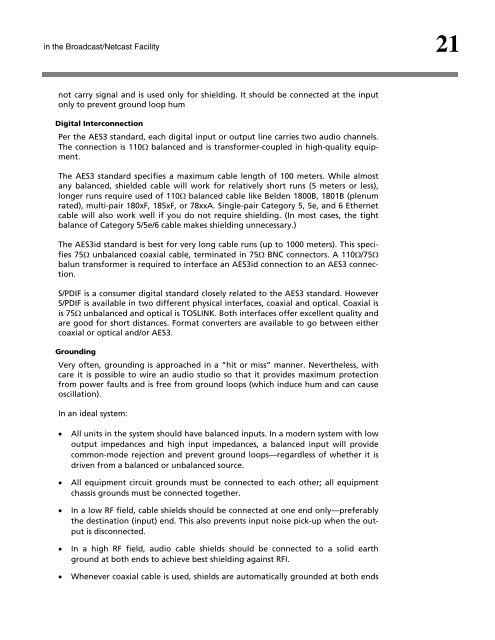Maintaining Audio Quality in the Broadcast Facility 2011 - Orban
Maintaining Audio Quality in the Broadcast Facility 2011 - Orban
Maintaining Audio Quality in the Broadcast Facility 2011 - Orban
Create successful ePaper yourself
Turn your PDF publications into a flip-book with our unique Google optimized e-Paper software.
<strong>in</strong> <strong>the</strong> <strong>Broadcast</strong>/Netcast <strong>Facility</strong> 21<br />
not carry signal and is used only for shield<strong>in</strong>g. It should be connected at <strong>the</strong> <strong>in</strong>put<br />
only to prevent ground loop hum<br />
Digital Interconnection<br />
Per <strong>the</strong> AES3 standard, each digital <strong>in</strong>put or output l<strong>in</strong>e carries two audio channels.<br />
The connection is 110� balanced and is transformer-coupled <strong>in</strong> high-quality equipment.<br />
The AES3 standard specifies a maximum cable length of 100 meters. While almost<br />
any balanced, shielded cable will work for relatively short runs (5 meters or less),<br />
longer runs require used of 110� balanced cable like Belden 1800B, 1801B (plenum<br />
rated), multi-pair 180xF, 185xF, or 78xxA. S<strong>in</strong>gle-pair Category 5, 5e, and 6 E<strong>the</strong>rnet<br />
cable will also work well if you do not require shield<strong>in</strong>g. (In most cases, <strong>the</strong> tight<br />
balance of Category 5/5e/6 cable makes shield<strong>in</strong>g unnecessary.)<br />
The AES3id standard is best for very long cable runs (up to 1000 meters). This specifies<br />
75� unbalanced coaxial cable, term<strong>in</strong>ated <strong>in</strong> 75� BNC connectors. A 110�/75�<br />
balun transformer is required to <strong>in</strong>terface an AES3id connection to an AES3 connection.<br />
S/PDIF is a consumer digital standard closely related to <strong>the</strong> AES3 standard. However<br />
S/PDIF is available <strong>in</strong> two different physical <strong>in</strong>terfaces, coaxial and optical. Coaxial is<br />
is 75� unbalanced and optical is TOSLINK. Both <strong>in</strong>terfaces offer excellent quality and<br />
are good for short distances. Format converters are available to go between ei<strong>the</strong>r<br />
coaxial or optical and/or AES3.<br />
Ground<strong>in</strong>g<br />
Very often, ground<strong>in</strong>g is approached <strong>in</strong> a “hit or miss” manner. Never<strong>the</strong>less, with<br />
care it is possible to wire an audio studio so that it provides maximum protection<br />
from power faults and is free from ground loops (which <strong>in</strong>duce hum and can cause<br />
oscillation).<br />
In an ideal system:<br />
� All units <strong>in</strong> <strong>the</strong> system should have balanced <strong>in</strong>puts. In a modern system with low<br />
output impedances and high <strong>in</strong>put impedances, a balanced <strong>in</strong>put will provide<br />
common-mode rejection and prevent ground loops—regardless of whe<strong>the</strong>r it is<br />
driven from a balanced or unbalanced source.<br />
� All equipment circuit grounds must be connected to each o<strong>the</strong>r; all equipment<br />
chassis grounds must be connected toge<strong>the</strong>r.<br />
� In a low RF field, cable shields should be connected at one end only—preferably<br />
<strong>the</strong> dest<strong>in</strong>ation (<strong>in</strong>put) end. This also prevents <strong>in</strong>put noise pick-up when <strong>the</strong> output<br />
is disconnected.<br />
� In a high RF field, audio cable shields should be connected to a solid earth<br />
ground at both ends to achieve best shield<strong>in</strong>g aga<strong>in</strong>st RFI.<br />
� Whenever coaxial cable is used, shields are automatically grounded at both ends



![[PDF] Using the ITU BS.1770-2 and CBS Loudness Meters ... - Orban](https://img.yumpu.com/50629372/1/190x245/pdf-using-the-itu-bs1770-2-and-cbs-loudness-meters-orban.jpg?quality=85)






![[PDF] Optimod-FM Feature Comparison - Orban](https://img.yumpu.com/41741615/1/190x245/pdf-optimod-fm-feature-comparison-orban.jpg?quality=85)






